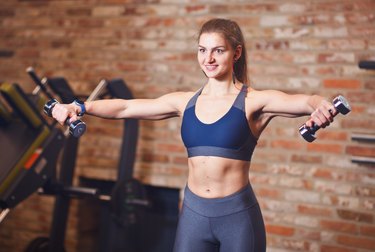
Building strong and sculpted shoulders is a goal for many bodybuilders and fitness enthusiasts. When it comes to training these muscles, one exercise that tops the list of favorites is the front lateral raise.
A variation of the lateral raise, this move requires strict form and lighter weight to avoid pain in the shoulders.
Video of the Day
Video of the Day
Shoulder Impingement Issues
If you're experiencing shoulder pain while doing the front lateral raise, there's a good chance you can blame it on an impingement issue. "The most common reason that front and lateral shoulder raises cause pain in adults is impingement of the rotator cuff tendons against the front edge of the tip of the shoulder blade in the upper phases of these exercises," Dr. David Geier, MD, orthopedic surgeon and sports medicine specialist tells LIVESTRONG.com.
The rotator cuff is a group of muscles and tendons that surround the shoulder joint, according to the Mayo Clinic. These muscles stabilize the ball in the shallow socket of the shoulder in overhead positions. When you have impingement or irritation of the rotator cuff tendons, Geier says you will often feel pain as you lift a weight above shoulder level and out away from your body.
Common symptoms of shoulder impingement include:
- Pain during certain range of motion exercises such as front and lateral raises
- Shoulder weakness
- Difficulty lifting overhead
- Difficulty reaching behind your back
You should also make a note of any other rotator cuff pain caused from a shoulder strain including swelling and tenderness in the front part of your shoulder, bruising, weakness, pain as you move and a decrease in your range of motion.
Read more: The Best Shoulder Exercises: How Many Reps and Sets?
Proper Form Counts
The three shoulder raise exercises you will see most often are the front lateral raise, the front raise and the lateral raise. The primary muscles at work are the deltoids, and more specifically, the anterior deltoid during the front and front lateral raise and the lateral deltoid during the lateral and front lateral raise. Additionally, you can expect to recruit the trapezius, supraspinatus, pectorals, wrist extensors and your core for stabilization while standing.
While each of these moves typically requires the use of dumbbells, you can also use bands or a cable machine. When using dumbbells, the key to keeping your shoulders injury-free is to keep the repetitions on the higher end and go light with the resistance. In fact, it's not uncommon to see training programs call for three sets of 12 to 15 repetitions of these exercises.
When raising the dumbbells during the front raise, how high you do will depend on when you feel tightness in your shoulder, according to ExRx.net. For some people, this could mean performing the move at 50 percent, while others may be able to reach absolute height because of good range of motion.
During the lifting phase of the lateral raise, your arms typically go into internal rotation. The American Council on Exercise suggests a slight external rotation at the 60 to 70-degree mark to help reduce potential impingement in the shoulder joint.
Managing Shoulder Pain
Both the front and lateral raise exercises are generally safe for most people. That said, there are occasions when you might experience pain. When this happens, stop the exercise, assess your form and make any adjustments. Then, reduce the weight you're lifting and decrease the number of repetitions and sets.
When you're done working out, follow the RICE protocol of rest, ice, compression and elevation.
- Rest immediately and continue until pain stops.
- Ice the area for 10 to 20 minutes, three times a day.
- Compress or wrap the area with kinesiology tape or bandage for extra support.
- Elevate your arm so your shoulder is in a comfortable position. Use the arm of a couch or stack towels and blankets to rest your arm on while icing the area.
You can also take an over-the-counter anti-inflammatory medication such as ibuprofen to help reduce pain and swelling. If you still have rotator cuff pain with lateral raise or the front lateral raise exercise, consider talking with an orthopedic sports medicine surgeon or a physical therapist to find out what is causing the pain.
According to the American Academy of Orthopaedic Surgeons, the goal of treatment is to reduce pain and restore function. Which means, in addition to assessing and diagnosing the problem, the treatment team will also teach you exercises you can do on your own to overcome the discomfort and return to exercise pain-free.
- American Council on Exercise: "Dumbbell Lateral Raise"
- ExRx: "Dumbbell Front Raise"
- American Academy of Orthopaedic Surgeons: "Shoulder Impingement/Rotator Cuff Tendinitis"
- Mayo Clinic: "Rotator Cuff Injury"
- Cleveland Clinic: "Shoulder Impingement Syndrome"
- Dr. David Geier: "Dr. David Geier, MD: Personal Interview"